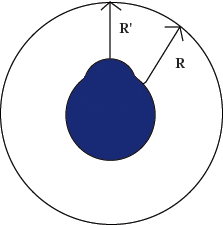
4.5 - Why Do Viscous Fingers Branch?
Why do bumps grow faster than the rest of the interface? The answer to this question is fundamental to understanding why the Hele-Shaw experiment gives rise to a treelike pattern when a less viscous fluid is injected into a more viscous one. Recall from our brief discussion above that the flow velocity is inversely proportional to the distance over which the pressure difference occurs. (You drink more water when you suck just as hard on a shorter straw.)
Consider a bump on a circular interface as in Figure . The pressure is the nearly the same at the bump interface as on the circular portion of the interface. On the other hand, the top of the bump is closer to the edge of the cell (R') than the rest of the interface (R). The same pressure difference over a shorter difference means greater flow velocity. As a result, the bump expands faster than the rest of the circular interface. This is why the interface is unstable, bumps grow, and viscous fingers develop. In a self-similar fashion, subsequent bumps grow on the fingers themselves causing the fingers to branch. And so on: a treelike structure develops.
 |
|
|
Previous: SimuLab 14 - The Fractal Dimensions of Hele-Shaw Patterns